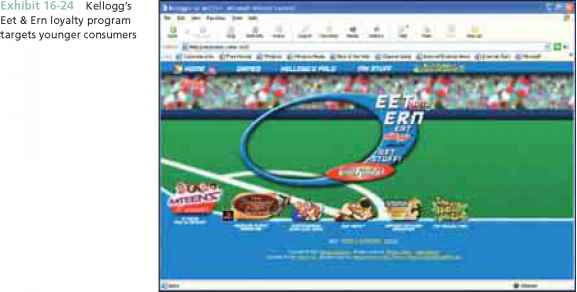Frequency Programs
One of the fastest-growing areas of sales promotion is the use of frequency programs (also referred to as continuity or loyalty programs). American Airlines was one of the first major companies to use loyalty programs when it introduced its AAdvantage frequent-flyer program in 1981. Since then frequency programs have become commonplace in a number of product and service categories, particularly travel and hospitality, as well as among retailers. Virtually every airline, car rental company, and hotel chain has some type of frequency program. American Airlines has nearly 44 million members in its AAdvantage program, while Marriott International has enlisted more than 18 million business travelers into its Rewards program.
Many packaged-goods companies are also developing frequency programs. Pills-bury, Nestlé, Kraft, and others have recently introduced continuity programs that offer consumers the opportunity to accumulate points for continuing to purchase their brands; the points can be redeemed for gifts and prizes. For example, Kellogg launched a frequency program called "Eet and Ern" that targets younger consumers. The program allows them to find a 10-character code on the inside of specially-marked packages of Kellogg products, enter the code at the EetandErn.com website, and receive a downloadable reward (Exhibit 16-24). They can also participate in other special promotions including contests, sweepstakes, special offers, games and other activities. The frequency program has been very effective and has helped Kellogg increase its sales despite the overall decline in cereal industry sales.49
Frequency programs have become particularly popular among grocery stores.50 Nearly 7,000 supermarkets now have loyalty programs that offer members discounts, a chance to accumulate points that can be redeemed for rewards, newsletters, and other special services. Loyalty programs are also used by a variety of other retailers, including department stores, home centers, bookstores, and even local bagel shops.
There are a number of reasons why frequency programs have become so popular. Marketers view these programs as a way of encouraging consumers to use their products or services on a continual basis and as a way of developing strong customer loyalty. Many companies are also realizing the importance of customer retention and understand that the key to retaining and growing market share is building relationships with loyal customers. Frequency programs also provide marketers with the opportunity to develop databases containing valuable information on their customers that can be used to better understand their needs, interests, and characteristics as well as to identify and track a company's most valuable customers. These databases can also be used to target specific programs and offers to customers to increase the amount they purchase and/or to build stronger relationships with them.
As frequency programs become more common, marketers will be challenged to find ways to use them as a means of differentiating their product, service, business, or retail store. It has been argued that many of the loyalty programs developed by packaged-goods marketers are really short-term promotions that overreward regular users and do little to develop long-term loyalty.5 Marketers must find ways to make them true loyalty programs rather than just frequent-buyer programs. This will require the careful management of databases to identify and track valuable customers and their purchase history and the strategic use of targeted loyalty promotions.

Continue reading here: Types of Trade Oriented Promotions
Was this article helpful?
Readers' Questions
-
Zula1 year ago
- Reply
-
eerik1 year ago
- Reply
-
WEGAHTA ABEL1 year ago
- Reply